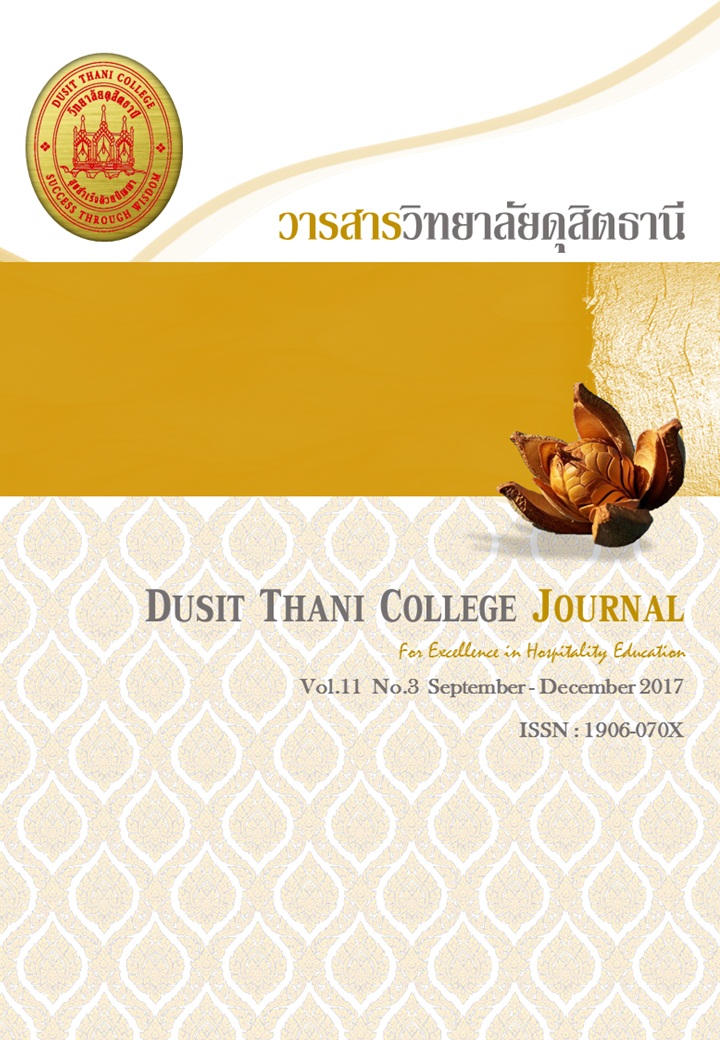The Development of Human Resource Management Pattern Enhancing Human Resource Strategic Partnership of Non-profit Organization
Main Article Content
Abstract
The purposes of this research paper are 1) to develop the elements of strategy for human resource management system, 2) to develop the human resource management pattern enhancing human resource strategic partnership of non-profit organization. The Pajek technique was adopt and used in order to analyze the information network. There were 17 human resource management experts to contribute the information for First and Second round-Ethnographic Delphi Futures Research (EDFR). And also Participatory Action Research (PAR) was conducted. The Cohen’s Kappa Coefficient was applied for evaluating consistency. The result reveals that the elements of the development of human resource management pattern enhancing Human Resource Strategic Partnership of Non-Profit Organization are the role of Strategic partner, the role of Administrative Experts, the roles of Change Agent, and the roles of Employee Champion, that the combination of four roles leads to the efficient strategic partner of the organization.
Article Details
Article Screening Policy
- All research and academic articles to be published must be considered and screened by three peer reviews in the relevant field / article.
- All articles, texts, illustrations and tables published in the journal are the personal opinions of the authors. Editors don't always have to agree. And no responsibility whatsoever is the sole responsibility of the author.
- The articles to be published must never be published. Where did you first publish? And not in the consideration of other journals If the audit found that there has been a duplicate publication It is the sole responsibility of the author.
- Any article that the reader sees as being plagiarized or impersonated without reference. Or mislead the work of the author Please let the journal editor know it will be your greatest blessing.
References
จิระจิตต์ บุนนาค (2544). “สถานภาพของการศึกษาการบริหารทรัพยากรมนุษย์ในปัจจุบัน” วารสารบริหารธุรกิจ. 91: 45-53, กรกฏาคม-กันยายน.
ชัยภัทร เกษมณี (2549). กลยุทธ์การบริหารองค์กรไมแสวงหากําไรเพื่อการพัฒนาเด็กและเยาวชน: กรณีศึกษา มูลนิธิศูนย์พิทักษ์สิทธิเด็ก. วิทยานิพนธ์หลักสูตรปริญญารัฐประศาสนศาสตรมหาบัณฑิต. สถาบันพระปกเกล้า
เนตร์พัณณา ยาวิราช (2552). ภาวะผู้นำ และผู้นำเชิงกลยุทธ์. กรุงเทพมหานคร. ทริปเพิ้ล กรุ๊ป.
ประเวศน์ มหารัตน์สกุล (2554). การจัดการทรัพยากรมนุษย์มุ่งสู่อนาคต. พิมพ์ครั้งที่ 3. กรุงเทพฯ: พิมพ์ตะวัน
ปริญญา หรุ่นโพธิ์ และ ธีระวัฒน์ จันทึก (2559). บทบาทและคุณลักษณะของ HR มุ่งสู่การเป็นหุ้นส่วนทาง
กลยุทธ์. Journal of Dusit Thani, Iss 1., January – June.
พิภพ อุดร และ วิทยา ด่านธำรงกุล (2557). 100 ข้อคิดบริหารคน จาก 100 ยอดนักบริหารไทย. กรุงเทพฯ: สถาบันทรัพยากรมนุษย์ มหาวิทยาลัยธรรมศาสตร์.
รัตน์ชนก จันยัง (2556). ประสิทธิภาพในการทำงานของพนักงานและปัจจัยที่มีผลต่อการเพิ่มประสิทธิภาพในการทำงานของพนักงานในองค์กรไม่แสวงผลกำไร. วิทยานิพนธ์. มหาวิทยาลัยเทคโนโลยีราชมงคลธัญบุรี
พิมลพรรณ เชื้อบางแก้ว (2551). การบริหารทรัพยากรมนุษย์. พิมพ์ครั้งที่ 8.กรุงเทพฯ: สำนักพิมพ์มหาวิทยาลัยกรุงเทพ.
Andreasen, A.R. and Kotler, P. (2003), Strategic Marketing for Non‐profit Organizations, 6th ed., New Jersey, Prentice‐Hall, Upper Saddle River.
Bas, A. (2012). Strategic HR Management : Strategy Facilitation Process by HR. Procedia-Social and Behavior Sciences 58: 313-321
Borzaga, C. and Santuari, A. (2000), "The innovative trends in the non‐profit sector in Europe: the emergence of social entrepreneurship”, acts at The Role of the Non‐profit Sector in Local Development: New Trends, Washington, DC, 11-12 September.
Caldwell, R. (2003). “The changing roles of personnel managers: old ambiguities, new uncertainties”, Journal of Management Studies, Vol.40 No.4, pp. 983-1004.
Conner, J. and Ulrich, D. (1996), “Human resource roles: creating value, not rhetoric”, Human Resource Planning, 19(3), 38-49.
Jeanette, L. (2009). “From administrative expert to strategic partner”, Employee Relation, 31(2), 182-196.
Joseph, C. S. and Gil. B. (2015). “How nonprofit organizations can ensure stability and sustainability through succession planning: make hr a strategic partner in the process”. Strategic Review, 14: 6
Lohmann, R.A. (2007). Charity, Philanthropy, Public service, or Enterprise: What are the big questions of Non-profit Management today?. Public Administration Review. 67 (3), 437-444.
Peter Goodge, (2006),"How to influence decisions as an HR business partner", Strategic HR Review, 5(2), 5 - 5
Ulrich, D. Brockbank, W. Yeung, A.K. and Lake, D.G. (1995). “Human Resource Competencies: an empirical assessment”, Human Resource Management, 34(4), 473-495.
Ulrich, D. (1998). Delivering Results. A New Mandate for Human Resource Professionals, Harvard Business School Press, Boston.
Ulrich, D. (1997). Human resource champions: the next agenda for adding value and delivering result, Business Week. Harvard Business School Press, Boston.
Ulrich, D. and Brockbank, W. (2005). The HR Value Proposition, Harvard Business School Press, Boston.
Ulrich D., Jon Younger, Wayne Brockbank, Mike Ulrich, (2012) "HR talent and the new HR competencies", Strategic HR Review, 11(4), 217 - 222


